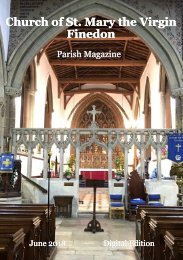Spring 2015 Newsletter
Finedon Local History Society Bi Annual Newsletter
Finedon Local History Society Bi Annual Newsletter
You also want an ePaper? Increase the reach of your titles
YUMPU automatically turns print PDFs into web optimized ePapers that Google loves.
The Volta Tower. Ron Clayton<br />
Following a period of thorough research Ron Clayton was able to clarify and correct a<br />
number of items of previous information believed to relate to Fine-don’s Volta Tower. It<br />
had been understood that the Volta Tower had been erected in memory of William<br />
Digby Mackworth-Dolben who was drowned off the coast of West Africa on September<br />
1st 1863 when the boat he was in with a Lieutenant M’Kinson and Mr Embank was capsized<br />
by a seal. This story is obtained from a log-book kept by his bat-man Thomas<br />
Baker Henfrey. How-ever, closer examination of the handwriting indicates that the boat<br />
was cap-sized by the seas (probably currents crossing the Bar of Lagos) and that he<br />
was accompanied by Lieutenant Atkinson and Mr Ewbank. At that time William Digby<br />
was Lieutenant Commander of HMS Investigator and was part of the British West Africa<br />
Squadron positioned to prevent the illegal trade in slaves.<br />
The name Volta was understood to come from a ship called the Volta on which William<br />
Digby had served but a search of naval records showed no trace of such a ship. Service<br />
records however revealed that when serving on HMS Bloodhound, Lieutenant<br />
Commander Dolben with Lieutenant Thurston Stringer went up the Volta River on an<br />
exploratory expedition. The river was mapped, taking depth readings at approximately<br />
every mile. It was suggested that this was the first time white men had ventured there,<br />
however it is very likely that the Portuguese had been before. Volta means turn back in<br />
Portuguese. Wil-liam Digby then sent a letter to the Royal Geographic Society on the<br />
expedi-tion but was told it was very scanty and of no great interest. Never-the-less the<br />
report was published and William Digby Mackworth-Dolben was made a Fel-low of the<br />
Royal Geographic Society. He would at this time have been listed together with the<br />
likes of Darwin, Livingstone, Speke and Burton. Interestingly, records show that the<br />
famous explorer Richard Burton sailed from Lagos on HMS Bloodhound when it was<br />
commanded by William Digby in 1862 and 1863.<br />
The Volta Tower itself was designed by Edwin Francis Law of Law & Harris and plans<br />
and drawings indicate this was in 1865, so it is unlikely that it was built in 1863 as previously<br />
thought. The finished building was 50% higher than the original plans (90+ feet<br />
as opposed to the planned 60+feet).This may have been a contributory factor in its<br />
collapse in 1951. Although rumour has it that the building was without mortar, this is<br />
untrue. It was built with mortar but was not pointed up.<br />
No specific reason has been attributed to the cause of the Volta Tower’s col-lapse but<br />
photographs of the time show that excavators in the Buccleuch Quarry came perilously<br />
close to the building. Furthermore, Harry Durden, a Finedon resident, reported at the<br />
inquest that at times blasting occurred twice weekly, although there was no blasting at<br />
the time of the collapse.

















